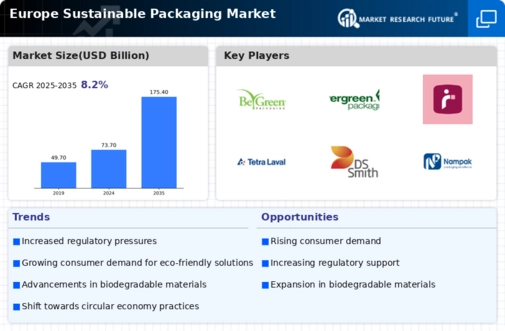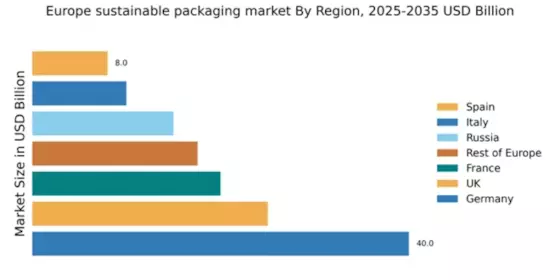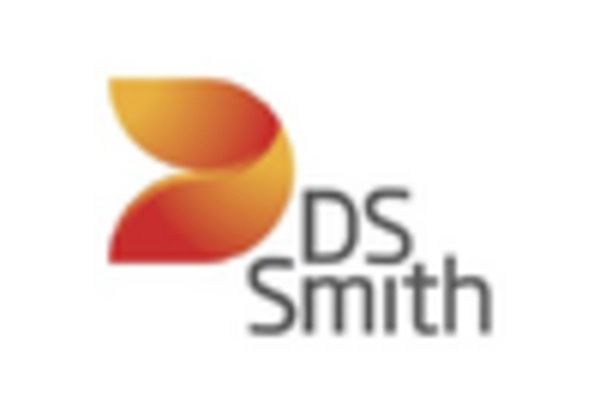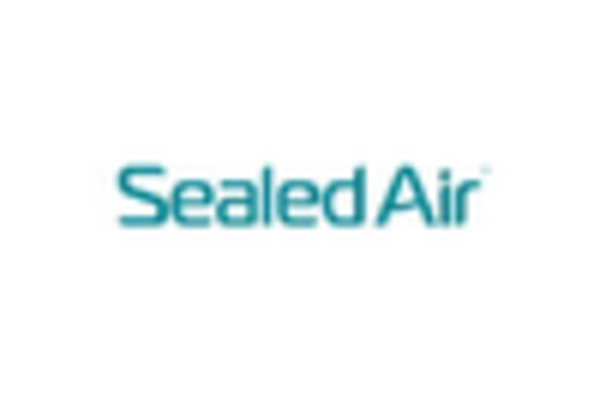Regulatory Framework Enhancements
The evolving regulatory landscape in Europe is a pivotal driver for the sustainable packaging market. Governments are increasingly implementing stringent regulations aimed at reducing plastic waste and promoting eco-friendly alternatives. For instance, the European Union's Single-Use Plastics Directive mandates a reduction in the consumption of certain plastic products, which has led to a surge in demand for sustainable packaging solutions. This regulatory push is expected to influence market dynamics significantly, as companies strive to comply with new standards. The sustainable packaging market is projected to grow as businesses adapt to these regulations, with estimates suggesting a compound annual growth rate (CAGR) of around 8% over the next five years. Such regulatory frameworks not only encourage innovation but also create a competitive environment where sustainable practices are prioritized.
Consumer Awareness and Preferences
Consumer awareness regarding environmental issues is a significant driver for the sustainable packaging market in Europe. As individuals become more informed about the impact of packaging waste on the environment, their preferences are shifting towards sustainable options. Surveys indicate that over 70% of European consumers are willing to pay a premium for products with sustainable packaging. This growing demand is compelling manufacturers to innovate and invest in eco-friendly materials. The sustainable packaging market is thus experiencing a transformation, as companies strive to meet these evolving consumer expectations. The potential for market growth is substantial, with projections estimating that the demand for sustainable packaging could increase by 20% in the coming years, driven by heightened consumer consciousness and preference for environmentally friendly products.
Corporate Sustainability Initiatives
Many companies in Europe are increasingly adopting corporate sustainability initiatives, which serve as a crucial driver for the sustainable packaging market. Organizations are recognizing the importance of aligning their operations with environmental goals, leading to a shift towards sustainable packaging solutions. This trend is particularly evident in sectors such as food and beverage, where brands are committing to using recyclable or compostable materials. According to recent data, approximately 60% of European companies have integrated sustainability into their core business strategies. This commitment is likely to bolster the sustainable packaging market, as firms seek to enhance their brand image and meet consumer expectations for environmentally responsible products. The financial implications are notable, with companies reporting a potential increase in revenue by up to 15% when adopting sustainable practices.
Technological Advancements in Materials
Technological advancements in materials science are playing a crucial role in shaping the sustainable packaging market. Innovations in biodegradable and compostable materials are enabling manufacturers to create packaging solutions that minimize environmental impact. For instance, the development of plant-based plastics and advanced recycling technologies is enhancing the feasibility of sustainable packaging options. The sustainable packaging market is likely to benefit from these advancements, as they provide viable alternatives to traditional plastic packaging. Research indicates that the market for bioplastics alone is expected to reach €3 billion by 2027, reflecting the growing interest in sustainable materials. These technological innovations not only address environmental concerns but also offer opportunities for cost savings and efficiency improvements in production processes.
Investment in Circular Economy Practices
The shift towards a circular economy is emerging as a vital driver for the sustainable packaging market in Europe. This approach emphasizes the importance of reusing, recycling, and reducing waste, which aligns with the principles of sustainability. Companies are increasingly investing in circular economy practices, such as designing packaging for recyclability and implementing take-back schemes. This trend is supported by various European initiatives aimed at promoting circularity, which are likely to enhance the sustainable packaging market. Reports suggest that the circular economy could generate an additional €1.8 trillion in economic benefits by 2030, highlighting the potential for growth in sustainable packaging solutions. As businesses adopt these practices, they not only contribute to environmental sustainability but also position themselves competitively in a market that increasingly values eco-consciousness.


















Leave a Comment